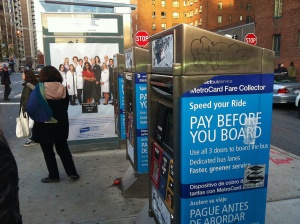Off-vehicle fare payment
Introduction
Fare payment aboard transit vehicles is often a source of delay for operators. For that reason, many transit providers find off-vehicle fare payment (sometimes called a Proof-of-Payment system) improves reliability and reduces dwell time at stops. It also allows people to board at all doors of vehicles, rather than only at the front, which also reduces dwell time. Off-vehicle fare payment may take the form of prepayment online or purchasing a ticket at a ticket vending machine (TVM). This practice is very common on North American light rail systems and has gained popularity as a way to improve service for many bus rapid transit systems.
Benefits
Off-vehicle fare payment dramatically speeds up boarding, by eliminating time-intensive payment process and allowing for boarding at all doors. The Federal Transit Administration notes:
Moving all fare collection off the bus offers the greatest potential for reducing dwell time. Not only is fare payment time reduced to zero, but all doors of the bus can be used for both loading and unloading.[1]
Off-vehicle fare payment is one of many strategies relating to boarding and alighting that can decrease end-to-end run time, and thus save money on operations.
Costs
Off-vehicle fare payment may require additional vending machines at transit station stops. Fare evasion may be another cost of using this type of fare payment, although it varies with characteristics of the system (barriers to entry, frequency of inspection, chance of evader being issued a citation rather than a warning, etc.). One study found that the Metro Orange Line, a bus rapid transit line in the San Fernando Valley, had an evasion rate of about 5.6%. The problem of fare evasion is also related to the further cost of paying employees to inspect tickets for proof of payment. For these reasons, off-vehicle fare payment may be most cost-effective on corridors with a high volume of boardings.[2]
References
- ↑ Federal Transit Administration. "Fare Collection." FTA.
- ↑ Transit Cooperative Research Program. “TCRP Synthesis 96: Off-Board Fare Payment Using Proof-of-Payment Verification.” 2012.
Additional Reading
Transit Cooperative Research Program. “TCRP Synthesis 96: Off-Board Fare Payment Using Proof-of-Payment Verification.” 2012.
- This report, sponsored by the Federal Transit Administration, includes a literature review of common practices in North America that include methods for measuring fare evasion in these types of systems, as well as a survey of transit providers that use a proof-of-payment system on at least one of their transit lines. Third, this report offers case studies of seven providers that use this type of system, including two in California - Los Angeles Metro and San Francisco MTA.
- May require free registration to access document.
Transit Cooperative Research Program. “TCRP Report 80: A Toolkit for Self-Service, Barrier-Free Fare Collection.” 2002.
- Published ten years prior to Synthesis 96, above, this report offers a basic look at off-vehicle fare payment, although it refers to it as self-service, barrier-free (SSBF) fare collection and focuses more on light rail than on transit in general.
- May require free registration to access document.
Lee, Jason. San Francisco Municipal Transportation Authority. "Uncovering San Francisco Muni’s Proof-of-Payment Patterns to Help Reduce Fare Evasion." 2009.
- This report describes the San Francisco MTA's effort to document and then reduce fare evasion on its Muni system, which uses off-board fare payment, or Proof-of-Payment, on its light rail, street car, and buses. The agency used a survey to determine it was losing about $19 million per year in revenue to fare evasion. The study also allowed the agency to educate customers on its efforts to curb fare evasion.
